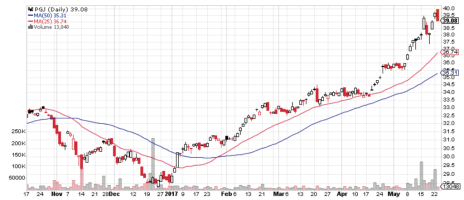Congratulations to subscribers of Cabot Global Stocks Explorer (formerly Cabot Emerging Markets Investor), who are right on top of one of the hottest trends in equity investing. That’s because emerging market stocks (and the Chinese stock market in particular) are, as my mother used to say, hotter than a two-dollar pistol.
Emerging Markets On a Tear
A quick look at the year-to-date numbers supplied by MSCI will make it clear. Since the year began, U.S. stocks have risen 7.5% and the MSCI World index has grown by 8.6%. And in that same time, the MSCI Emerging Markets index is up 17.2%. The U.S., the global market and emerging markets are all in bull territory, but EM stocks are tearing it up.
Looking at individual emerging market countries also yields fascinating results. Thus far in 2017, only two countries are in negative territory, with Russia the biggest loser, down 5.2%. Among the other countries that we are most familiar with through the performance of their American Depositary Receipts, Chinese stocks are up 19.4% and India has gained 21%.
[text_ad]
In the useless trivia department, Poland is the top-performing emerging market with a stunning 33.1% rise. (That doesn’t help us much, as there’s not a single Polish stock on our ADR list.) On the developed-nation side, the top performer is Austria, which has soared by 25.2% this year. And, somewhat surprisingly, the worst-performing developed market in 2017 has been Canada—Canadian stocks have managed an advance of just 0.1%.
There are probably many other, more subtle ways to look at the global stock market. These MSCI numbers are all U.S. dollar-denominated, so they include the results of currency fluctuations. But I think the picture is an essentially accurate one.
In the U.S., by the way, the stocks of just six companies—Facebook (FB), Apple (AAPL), Amazon (AMZN), Microsoft (MSFT), Alphabet (GOOG) and Netflix (NFLX)—are responsible for almost half of the YTD gains in the S&P 500. That’s just a reflection of the preference (and requirement) of big investors for stocks whose mega-cap status can absorb a ton of cash.
The lessons to be gleaned from all these numbers are pretty obvious, but they’re no less important because they’re right there to be seen. The first one—and the most important—is that we are in a bull market. As the writer of a growth investing advisory, I can’t emphasize that enough, despite the recent selloff in many indexes.
Bull markets have their own challenges, including how to jump into stocks when they have left their moving averages behind and are climbing into new-high territory, and how to deal with quick declines that go hand in hand with big run ups.
Bull markets aren’t easy, despite how a successful earnings season has made things look so far. But they’re what growth investors live for, and you’ve got to figure out how to get some money working for you when the bulls are in charge.
One note: Brazil, which has had more than its share of political turmoil, has been hit by another crisis. The country’s president was apparently taped talking about payoffs to a jailed associate to buy his silence. The new scandal dropped the iShares MSCI Brazil ETF (EWZ) by as much as 19%, and the rebound has been feeble.
The weakness in Brazilian stocks also took a bite out of LATAM Airlines (LTM), a Chilean airline for which Brazil is a big revenue source. LTM was a component of the portfolio for Cabot Global Stocks Explorer until we sold it last week at a 12% loss. We’ll be watching closely to see if there is any other Brazilian contagion, but things look pretty calm now.
Portfolio Centered in Chinese Stock Market
Fortunately, a majority of the portfolio’s capital is concentrated in the Chinese stock market, which has been having a great year. The PowerShares Golden Dragon China ETF (PGJ), which tracks Chinese ADRs on U.S exchanges, shows both the strength and volatility of this investment universe. Here’s what the daily chart for PGJ looks like.
One of the principles of growth investing is staying in step with the market, increasing your investments when the buyers are in control and retreating into cash when the sellers are doing damage. Right now, despite the occasional hiccup, the buyers are definitely in control of the Chinese stock market.
If you’d like a knowledgeable guide to buying and managing emerging market stocks, a click right here will get you started.
This piece was an edited excerpt from the May 18 issue of Cabot Global Stocks Explorer by Paul Goodwin, who focuses on presenting high growth opportunities in emerging markets. If you’re interested in joining Cabot Global Stocks Explorer, click here.
[author_ad]


